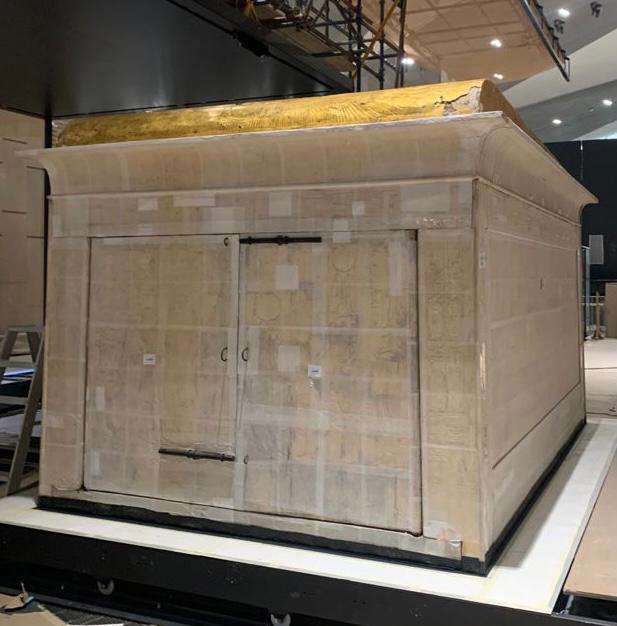The experts of restoring and archaeologists of the Grand Egyptian Museum (GEM), in cooperation with one of the national companies, completed the transfer and re-installation of the second compartment of the young king Tutankhamun (circa 1325 B.C) inside the window designated for it with the rest of the chapels of the young king.
Maj. Gen. Atef Moftah, General Supervisor of the Grand Egyptian Museum (GEM) and the surrounding area, indicated that the installation of the royal compartment took about 4 hours of meticulous work.
He added that the great work of the Egyptian experts gives an honorable picture of the Egyptian restorers and the extent of their ingenuity in dealing with antiquities of a special nature.
Maj. Gen. Moftah stressed that the process of assembling and installation of the compartment was done with great skill to achieve it. Three compartments were transferred during the last period from the Egyptian Museum in Tahrir, in the west of Cairo to the GEM.
The fourth compartment, which is the smallest, then the third, then the second compartment, which is the largest pieces that have been transferred so far from the treasures of the golden king Tutankhamun.
Dr. Al-Tayeb Abbas, Assistant Minister of Tourism and Antiquities for Archaeological Affairs at the GEM, explained that this compartment was made of gilded wood.
It was found in the King's possessions in his tomb on the western bank of the Nile River next Luxor, which was discovered in November 1922, and then transferred with the rest of the pieces to the Egyptian Museum in Tahrir, where they were displayed.
Dr. Abbas said that the first remaining compartment will be moved soon to display each of the compartments of King Tutankhamun in a special window, according to the latest museum display methods in the halls dedicated to displaying the king’s treasures.
The treasures have an area of about 7200 square meters and are equipped with the latest museum display methods from two environmentally controlled exhibitions in terms of fixed temperature, humidity and lighting, in addition to illustrative means of graphics and explanation cards for each piece, as well as display screens showing the scenario of the young king.
Dr. Abbas stressed that the work of placing other artifacts of King Tutankhamun is going on regularly and according to its schedule.
On his part, Moamen Othman, Head of the Museums Sector under the Ministry of Tourism and Antiquities, confirmed that the process of transferring the royal compartment, was carried out in accordance with the principles and precise scientific standards.
He revealed that the compartment was dismantled into 15 parts in the same style and method of industry used by the ancient Egyptian, and then each part was inpidually wrapped inside an internal box and an external one using acid-free materials.
Othman pointed out that the work team from the Grand Egyptian Museum and the Egyptian Museum in Tahrir continues to work day and night to complete the restoration of the first compartment in preparation for its transfer and display inside the window designated for it in the treasures halls of the young king.
Dr. Issa Zeidan, Director General of Executive Affairs for the Restoration and Transfer of Antiquities at the Grand Egyptian Museum, confirmed that the work team carried out restoration, strengthening, protection works for the compartment before the transfer process.
Zeidan indicated that experts strengthened weakness and in parts of the compartment, as well as to identify the components of the metal in the cabin using X-ray fluorescence, in addition to preparing a comprehensive report on the condition of the compartment before the transportation process, which would contribute significantly to the process of the ensuing operations.
Translated by Ahmed Moamar













